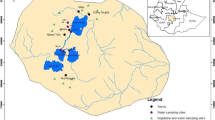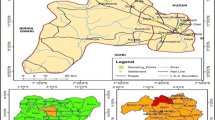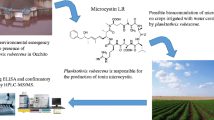Abstract
Microcystins (MCs) are hepatotoxic secondary metabolites produced by several genera of cyanobacteria. Human exposure routes include drinking contaminated water and consuming contaminated fish, vegetables, crops, and even food supplements that contain cyanotoxin. This study investigated the presence of MCs in a stream with a long history of use as a source of water for irrigation farming. To establish the risk of a lack of monitoring programs, we studied MCs contamination of irrigated vegetables. Toxin levels in the water were generally <0.05 μg L−1 in all the investigated stations. Total microcystin concentrations in spinach (0.306 μg Kg−1 upstream and 0.217 μg Kg−1 downstream), lettuce (0.085 μg Kg−1 upstream and 0.462 μg Kg−1 downstream), carrot (0.050 μg Kg−1 downstream and 0.116 μg Kg−1 downstream), cabbage (0.014 μg Kg−1 upstream and 0.031 μg Kg−1 downstream), tomatoes (0.233 μg Kg−1 upstream), and bitter leaf (0.460 μg Kg−1 upstream and 0.050 μg Kg−1 downstream) collected in March were higher than the levels detected in samples of the same vegetables collected in April. These results highlight Nigeria’s severe public health problem, especially in regions with long dry season spells. The level of MCs contamination of irrigated vegetables implies a potential for chronic exposure and associated health challenges.






Similar content being viewed by others
Availability of data and materials
The datasets generated during and/or analyzed during the current study are available from the corresponding author on reasonable request.
References
APHA (2005) Standard methods for the examination of water and wastewater. American Public Health Association, American Water Works Association, Washington, DC
Bartram J, Rees G (1999) Monitoring bathing waters: a practical guide to the design and implementation of assessments and monitoring programmes. CRC Press, Washington
Bates DM (2010) lme4: Mixed-effects modeling with R
Bouaïcha N, Miles CO, Beach DG et al (2019) Structural diversity, characterization and toxicology of microcystins. Toxins (Basel) 11:714
Bruno M, Gallo P, Messineo V, Melchiorre S (2012) Health risk associated with microcystin presence in the environment: the case of an Italian Lake (Lake Vico, Central Italy). Int J Env Prot 2:34–41
Bununu YA, Ludin ANM, Hosni N (2015) City profile: Kaduna. Cities 49:53–65
Cancer IA for R on (2010) Ingested nitrate and nitrite, and cyanobacterial peptide toxins. IARC monographs on the evaluation of carcinogenic risks to humans 94
Carmichael WW (1992) Cyanobacteria secondary metabolites—the cyanotoxins. J Appl Bacteriol 72:445–459
Chen J, Song L, Dai J et al (2004) Effects of microcystins on the growth and the activity of superoxide dismutase and peroxidase of rape (Brassica napus L.) and rice (Oryza sativa L.). Toxicon 43:393–400
Chia MA, Kwaghe MJ (2015) Microcystins contamination of surface water supply sources in Zaria-Nigeria. Environ Monit Assess 187:1–12
Chia AM, Abolude DS, Ladan Z et al (2009a) The presence of microcystins in aquatic ecosystems in Northern Nigeria: Zaria as a case study. Res J Environ Toxicol 3:170–178. https://doi.org/10.3923/rjet.2009.170.178
Chia AM, Oniye SJ, Ladan Z et al (2009b) A survey for the presence of microcystins in aquaculture ponds in Zaria, Northern-Nigeria: possible public health implication. Afr J Biotechnol 8:6282–6289. https://doi.org/10.5897/AJB09.1263
Chia MA, Cordeiro-Araujo MK, do Carmo Bittencourt-Oliveira M (2015) Growth and antioxidant response of Microcystis aeruginosa (Cyanobacteria) exposed to anatoxin-a. Harmful Algae 49:135–146
Chia MA, Auta ZZ, Esson AE et al (2019) Assessment of microcystin contamination of Amaranthus hybridus, Brassica oleracea, and Lactuca sativa sold in markets: a case study of Zaria, Nigeria. Environ Monit Assess 191:569. https://doi.org/10.1007/s10661-019-7725-4
Chia MA, Abdulwahab R, Ameh I et al (2021) Farmed tilapia as an exposure route to microcystins in Zaria-Nigeria: a seasonal investigation. Environ Pollut 271:116366
Constable GA, Rawson HM (1980) Effect of leaf position, expansion and age on photosynthesis, transpiration and water use efficiency of cotton. Aust J Plant Physiol 7:89–100
Cordeiro-Araújo MK, Chia MA, de Toledo Arruda-Neto JD et al (2016) Microcystin-LR bioaccumulation and depuration kinetics in lettuce and arugula: human health risk assessment. Sci Total Environ 566:1379–1386
Crush JR, Briggs LR, Sprosen JM, Nichols SN (2008) Effect of irrigation with lake water containing microcystins on microcystin content and growth of ryegrass, clover, rape, and lettuce. Environ Toxicol An Int J 23:246–252
Díez-Quijada L, Guzmán-Guillén R, Prieto Ortega AI et al (2018) New method for simultaneous determination of microcystins and cylindrospermopsin in vegetable matrices by SPE-UPLC-MS/MS. Toxins (Basel) 10:406
do Carmo Bittencourt-Oliveira M, Cordeiro-Araújo MK, Chia MA et al (2016) Lettuce irrigated with contaminated water: photosynthetic effects, antioxidative response and bioaccumulation of microcystin congeners. Ecotoxicol Environ Saf 128:83–90
Duy TN, Lam PKS, Shaw GR, Connell DW (2000) Toxicology and risk assessment of freshwater cyanobacterial (blue-green algal) toxins in water. Rev Environ Contam Toxicol 2000:113–185
El Gamal AA (2010) Biological importance of marine algae. Saudi Pharm J 18:1–25
Falconer IR, Humpage AR (2005) Health risk assessment of cyanobacterial (blue-green algal) toxins in drinking water. Int J Environ Res Public Health 2:43–50
Fontanillo M, Köhn M (2018) Microcystins: synthesis and structure–activity relationship studies toward PP1 and PP2A. Bioorg Med Chem 26:1118–1126
Griffith AW, Gobler CJ (2020) Harmful algal blooms: a climate change co-stressor in marine and freshwater ecosystems. Harmful Algae 91:101590
Hereman TC, do Carmo Bittencourt-Oliveira M (2012) Bioaccumulation of microcystins in lettuce. J Phycol 48:1535–1537
Humpage AR, Hardy SJ, Moore EJ et al (2000) Microcystins (cyanobacterial toxins) in drinking water enhance the growth of aberrant crypt foci in the mouse colon. J Toxicol Environ Heal Part A 61:155–165
Kadiri MO, Isagba S, Ogbebor JU et al (2020) The presence of microcystins in the coastal waters of Nigeria, from the Bights of Bonny and Benin, Gulf of Guinea. Environ Sci Pollut Res 27:35284–35293. https://doi.org/10.1007/s11356-020-09740-x
Kimambo ON, Gumbo JR, Chikoore H (2019) The occurrence of cyanobacteria blooms in freshwater ecosystems and their link with hydro-meteorological and environmental variations in Tanzania. Heliyon 5:e01312
Liu P, Wei J, Yang K et al (2018) Isolation, molecular identification, and characterization of a unique toxic cyanobacterium Microcystis sp. found in Hunan Province, China. J Toxicol Environ Heal part A 81:1142–1149
Machado J, Azevedo J, Freitas M et al (2017) Analysis of the use of microcystin-contaminated water in the growth and nutritional quality of the root-vegetable, Daucus carota. Environ Sci Pollut Res 24:752–764
Massey IY, Yang F, Ding Z et al (2018) Exposure routes and health effects of microcystins on animals and humans: a mini-review. Toxicon 151:156–162
Mohamed ZA, Al Shehri AM (2009) Microcystins in groundwater wells and their accumulation in vegetable plants irrigated with contaminated waters in Saudi Arabia. J Hazard Mater 172:310–315
Mohamed Z, Ahmed Z, Bakr A et al (2020) Detection of free and bound microcystins in tilapia fish from Egyptian fishpond farms and its related public health risk assessment. J Consum Prot Food Saf 15:37–47
Mohamed Z, Bakr A, Campos A et al (2022) Growth inhibition and microcystin accumulation in bush bean (Phaseolus vulgaris L.) plant irrigated with water containing toxic Chrooccocus minutus. Agric Water Manag 261:107381
Otten TG, Paerl HW (2015) Health effects of toxic cyanobacteria in US drinking and recreational waters: our current understanding and proposed direction. Curr Environ Health Rep 2:75–84
Peuthert A, Kun L, Baik S, Pflugmacher S (2015) Transfer of cyanobacterial toxins into edible plants via irrigation with lake water – a Chinese case study. Aperito J Aquat Mar Ecosys 1:1–7
Pham T-L, Utsumi M (2018) An overview of the accumulation of microcystins in aquatic ecosystems. J Environ Manag 213:520–529
Picardo M, Filatova D, Nunez O, Farré M (2019) Recent advances in the detection of natural toxins in freshwater environments. TrAC Trends Anal Chem 112:75–86
Turner AD, Dhanji-Rapkova M, O’Neill A et al (2018) Analysis of microcystins in cyanobacterial blooms from freshwater bodies in England. Toxins (Basel) 10:39
Ueno Y, Nagata S, Tsutsumi T et al (1996) Detection of microcystins, a blue-green algal hepatotoxin, in drinking water sampled in Haimen and Fusui, endemic areas of primary liver cancer in China, by highly sensitive immunoassay. Carcinogenesis 17:1317–1321. https://doi.org/10.1093/carcin/17.6.1317
Wei J, Xie X, Huang F et al (2020) Simultaneous Microcystis algicidal and microcystin synthesis inhibition by a red pigment prodigiosin. Environ Pollut 256:113444
WHO CT (1998) Microcystin-LR, Guidelines for drinking water quality. World Heal Organ Geneva, Geneva, pp 95–110
WHO G (2011) Guidelines for drinking-water quality. World Health Organ 216:303–304
Wood S, Briggs L, Sprosen J, Bloxham M, Ruck J, Wear B (2004) A report on microcystin levels in water, trout and freshwater mussels in Lakes Rotoiti and Rotoehu during 2003/2004. A Report for Environment Bay of Plenty
Zhang D, Xie P, Chen J (2010) Effects of temperature on the stability of microcystins in muscle of fish and its consequences for food safety. Bull Environ Contam Toxicol 84:202–207
Zhao S, Yuan C, Tuo X et al (2021) MCLR induces dysregulation of calcium homeostasis and endoplasmic reticulum stress resulting in apoptosis in Sertoli cells. Chemosphere 263:127868
Author information
Authors and Affiliations
Contributions
All authors contributed to the study’s conception and design. Material preparation, data collection, and analysis were performed by Halima Abdullahi, Suwebat Ayanronke Akinyemi, Maria do Carmo Bittencourt-Oliveira, Yahuza Tanimu, and Mathias Ahii Chia. The first draft of the manuscript was written by Halima Abdullahi, and all authors commented on previous versions of the manuscript. All authors read and approved the final manuscript.
Corresponding author
Ethics declarations
Ethics approval
The study did not require ethical clearance because it does not involve human subjects.
Consent to participate
The study did not require consent to participate because it does not involve human subjects.
Consent for publication
The study was not a case study requiring consent to publish from subjects.
Competing interests
The authors declare no competing interests.
Additional information
Responsible Editor: Vitor Vasconcelos
Publisher’s note
Springer Nature remains neutral with regard to jurisdictional claims in published maps and institutional affiliations.
Rights and permissions
About this article
Cite this article
Abdullahi, H., Tanimu, Y., Akinyemi, S.A. et al. Assessment of microcystins in surface water and irrigated vegetables in Kwaru stream, Hayin Danmani, Kaduna-Nigeria. Environ Sci Pollut Res 29, 78303–78313 (2022). https://doi.org/10.1007/s11356-022-21381-w
Received:
Accepted:
Published:
Issue Date:
DOI: https://doi.org/10.1007/s11356-022-21381-w




